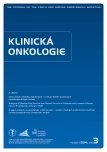Inverted Papiloma and Its Rare Forms
Authors:
G. Bugová 1; M. Jeseňák 2; P. Wallenfels 3; B. Ondrušová 1; A. Hajtman 1
Authors‘ workplace:
Klinika ORL a chirurgie hlavy a krku, Univerzita Komenského v Bratislave, Jesseniova lekárska fakulta v Martine, Univerzitná nemocnica Martin
1; Klinika detí a dorastu, Univerzita Komenského v Bratislave, Jesseniova lekárska fakulta v Martine, Univerzitná nemocnica Martin
2; ORL oddelenie, NsP Prievidza so sídlom v Bojniciach
3
Published in:
Klin Onkol 2014; 27(3): 203-206
Category:
Case Report
Overview
Authors address the issue of a frequent benign tumour of the nasal cavity and paranasal sinuses – inverted papilloma. They analyse the available diagnostic methods and treatment options. On the background of selected case reports of a rare malignant transformation they emphasize the need for longterm dispensarization as a part of management plan for patients with this oncological disease.
Key words:
inverted papilloma – head and neck neoplasms – neoplastic cell transformation
The authors declare they have no potential conflicts of interest concerning drugs, products, or services used in the study.
The Editorial Board declares that the manuscript met the ICMJE “uniform requirements” for biomedical papers.
Submitted:
20. 8. 2013
Accepted:
23. 2. 2014
Sources
1. Sičák M et al (eds). Rinológia – choroby nosa a prinosových dutín. 1. vyd. Martin: Kozák Press 2006: 134.
2. Strojan P, Jereb S, Borsos I et al. Radiotherapy for inverted papilloma: a case report and review of the literature. Radiol Oncol 2013; 47(1): 71– 76. doi: 10.2478/ v10019- 012- 0045-8.
3. Lund V, Stammberger H, Nicolai P et al. European position paper on endoscopic managment of tumors of the nose, paranasal sinuses and skull base. Rhinol Suppl 2010; 22: 1– 143.
4. Barnes L. Diseases of the nasal cavity, paranasal sinuses and nasopharynx. In: Barnes L (ed.). Surgical pathology of the head and neck. New York: Informa Healthcare 2009; 343– 422.
5. Lawson W, Patel ZM. The evolution of management for inverted papilloma: an analysis of 200 cases. Otolaryngol Head Neck Surg 2009; 140(3): 330– 335. doi: 10.1016/ j.otohns.2008.11.010.
6. Bhalla RK, Wright ED. Predicting the site of attachment of sinonasal inverted papilloma. Rhinology 2009; 47(4): 345– 348. doi: 10.4193/ Rhin08.229.
7. Lawson W, Patel ZM. The evolution of management for inverted papilloma: an analysis of 200 cases. Otolaryngol Head Neck Surg 2009; 140(3): 330– 335. doi: 10.1016/ j.otohns.2008.11.010.
8. Krouse JH. Development of a staging system for inverted papilloma. Laryngoscope 2000; 110(6): 965– 968.
9. Kamel R, Khaled A, Kandil T. Inverted papilloma: new classification and guidelines for endoscopic surgery. American J Rhiunol 2005; 19(4): 358– 364.
10. Dragonetti A, Gera R, Sciuto A et al. Sinonasal inverted papilloma: 84 patients treated by endoscopy and proposal for a new classification. Rhinology 2011; 49(2): 207– 213. doi: 10.4193/ Rhino09.053.
11. Balatková Z, Vokurka J, Plzák J et al. Léčba invertovaného papilomu. Endoskopie 2012; 21(1): 35– 37.
12. Sautter NB, Cannady SB, Citardi MJ et al. Comparison of open versus endoscopic resection of inverted papilloma. Am J Rhinol 2007; 21(3): 320– 323.
13. Kraft M, Simmen D, Kaufmann T et al. Long‑term results of endonasal sinus surgery in sinonasal papillomas. Laryngoscope 2003; 113(9): 1541– 1547.
Labels
Paediatric clinical oncology Surgery Clinical oncologyArticle was published in
Clinical Oncology

2014 Issue 3
Most read in this issue
- Very Late Effects of Radiotherapy – Limiting Factor of Current Radiotherapy Techniques
- Inverted Papiloma and Its Rare Forms
- Cancer in Elderly
- Case Report of a Patient with Advanced and Disseminated Gastric Carcinoma Treated by S-1
